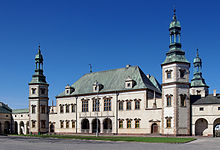Episcopal Palace Kielce
The Palace of the Krakow Bishops in Kielce ( Polish: pałac Biskupów Krakowskich w Kielcach ) is the former summer residence of the Bishops of Krakow in Kielce , Poland . The building was built in the 17th century (1637–1644) in the Mannerist- early Baroque style, with Italian and Polish influences being combined in a special way. The building is currently used for a collection of paintings by the Polish National Museum.
history
The Kielc residence was laid out by Chancellor Jakub Zadzik .
The building, begun in 1637, has a towering roof and is flanked by towers on the sides. The symmetrical, three-part plan, the loggias, the towers and the interior design are reminiscent of the royal residences of the immediately preceding period, such as Ujazdowski Castle or the original Villa Regia in Warsaw . The palace is considered to be the main work of Tommaso Poncino from Lugano (approx. 1590–1659), to which the architecture of numerous buildings in Poland can be traced back.
The palace was enlarged in the 18th century and redesigned in the French style. One-story wings have now been built on both sides of the courtyard. The Renaissance garden has recently been reconstructed.
use
After the nationalization of the episcopal properties (1789), various institutions were housed in the palace, such as the
- Mining Headquarters (1816–1827)
- Mining Academy, the first technical university in Poland
- Provincial government of the Russian province of Kielce (1867-1914)
During the Second Polish Republic , the tower domes that were removed in the 19th century were rebuilt and the interior design was reconstructed. From 1919 to 1939 and from 1945 to 1970 which was in the palace building Provincial Administrative the Kielce province . Since 1971 the palace has been a branch of the National Museum.
Web links
Individual evidence
Coordinates: 50 ° 52 ′ 9 ″ N , 20 ° 37 ′ 39 ″ E

